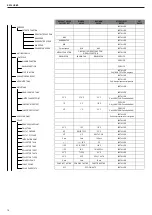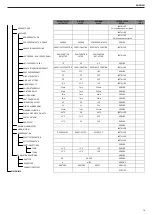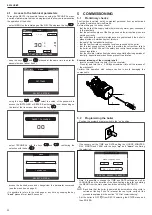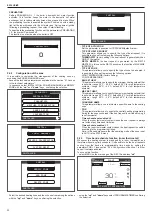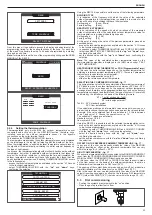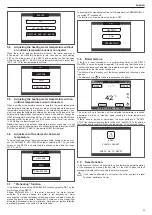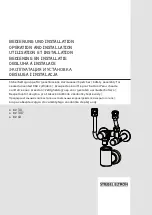
10
EXCLUSIVE
b
Under the safety valve, install a water collecting funnel with the
corresponding discharge in the event of leaks due to the overpressure
of the heating system. The domestic hot water circuit does not need a
safety valve, but make sure that the pressure of waterworks does not
exceed 6 bar. In case of doubts, install a pressure reducer.
b
Prior to ignition, make sure that the boiler is designed to operate
with the gas available; this can be checked by the wording on the
packaging and by the adhesive label indicating the gas type.
b
It is very important to highlight that in some cases the flues are under
pressure, so the joints of the various elements must be airtight.
3.2 Installation regulations
The installation must be carried out by qualified personnel, in compliance
with the following reference standards:
- UNI 7129-7131
- CEI 64-8.
Always comply with local standards of the Fire Department, the Gas
Company and with possible municipal dispositions.
POSITION
EXCLUSIVE
is a wall-hung boiler for heating and for the production of hot
water. There are two categories, depending on the type of installation:
- B23P-B53P boiler type - forced open installation, with flue gas discharge
pipe and pick-up of combustion air from the installation area. If the
boiler is not installed outdoors, the air intake in the installation area is
compulsory;
- C13,C13x; C33,C33x; C43,C43x; C53,C53x; C63,C63x; C83,C83x,
C93,C93x type boiler: appliance with airtight chamber, with flue gas
discharge pipe and pick-up of combustion air from outside.
It does not require an air intake point in the installation area.
This type MUST be installed using concentric pipes, or other types of
discharge designed for condensing boilers with an airtight chamber.
The boiler can be installed indoor and outdoor, in a partially protected
place (fig. 6, i.e. a place where the boiler is not exposed to direct contact
or infiltration of rain, snow or hail). The boiler can operate in a temperature
range from -5°C to +60°C.
ANTI-FREEZE SYSTEM
The boiler is fitted as standard with an automatic anti-freeze system that
actives when the water temperature in the primary circuit falls below 5°C.
This system is always active, guaranteeing boiler protection down to an
installation area temperature of -5°C.
b
To take advantage of this protection, based on the burner
operation, the boiler must be able to switch itself on; any
lockout condition (i.e. due to a lack of gas or electrical supply,
or the intervention of a safety device) therefore deactivates the
protection.
Under normal operating conditions, the boiler can self-protect itself from frost.
In areas where temperatures may fall below 0°C, or when the machine is
left unpowered for long periods, you are advised to use a good quality anti-
freeze liquid in the primary circuit to avoid the risk of freezing if you do not
want to drain the heating system.
Carefully follow the manufacturer’s instructions with regards not only the
percentage of anti-freeze liquid to be used for the minimum temperature
at which you want to keep the machine circuit, but also the duration and
disposal of the liquid itself. For the hot domestic water part, we recommend
you drain the circuit. The boiler component materials are resistant to ethylene
glycol based anti-freeze liquids. Anti-freeze kits and upper cover kits are also
available for boilers installed outdoors in a partially protected place.
MINIMUM DISTANCES (fig. 6a-6b)
To ensure access to the boiler for normal maintenance operations, respect
the minimum installation clearances envisaged.
For correct appliance positioning, bear in mind that:
- it must not be placed above a cooker or other cooking device
- it is forbidden to leave inflammable products in the room where the boiler
is installed
- heat-sensitive walls (e.g. wooden walls) must be protected with proper
insulation.
b
In case of installation it is ESSENTIAL to provide the necessary
space for the introduction of the instrument for the combustion
analysis check. In fig. 6b is shown a sample drawing where the
distances between boiler and cabinet/niche were obtained using a
300mm length tool. Longer lengths of tools require more space.
3.3 Elimination of air from the heating circuit and
from the boiler (fig. 7)
During the initial installation phase, or in the event of extraordinary
maintenance, you are advised to perform the following sequence of
operations:
1. Open by two or three turns the automatic relief valve cap (
A
) and
leave
it open.
2. Open the system filling tap located on the water unit.
3. Switch on the electricity supply to the boiler, leaving the gas tap turned off.
4. Activate a heat request via the room thermostat or the remote control
panel, so that the 3-way valve goes into heating mode.
5. Activate a request for DHW as follows: open a tap for 30” per minute so
that the three-way valve cycles from heating to DHW and vice versa for
about ten times (in this situation, the boiler will go into alarm due to lack
of gas, therefore reset it whenever this is proposed).
6. Continue the sequence until no more air is felt coming from the air vent
valve.
7. Check the system pressure level is correct (the ideal level is 1 bar).
8. Turn off the system filling tap.
9. Turn on the gas tap and ignite the boiler.
3.4 Positioning the wall-mounted boiler and hydraulic
connections (fig. 8-9-9a)
The boiler comes as standard with a boiler support plate. The position and
dimension of hydraulic fittings are shown in the detail drawing.
For the assembly, proceed as follows:
- fasten the boiler support plate (
F
) to the wall and use a spirit level to
make sure it is perfectly horizontal
- mark the 4 holes (ø 6 mm) envisaged for securing the boiler support
plate (
F
)
- make sure that all measurements are exact, then drill the wall using drill
tips with the diameters indicated above
- fix the plate with the built-in template to the wall
- fix the pipe supplied in the documentation envelope to the safety valve
fitting, then connect it to an appropriate drain system
- carry out the hydraulic connections.
3.5 Electrical wiring (fig. 10-11)
Low voltage connections
Carry out the low voltage connections as follows:
- use the external cable box supplied as standard
- unscrew the fixing screws of the cover (
V
)
- carry out the connections as shown in fig. 11
b
It is recommended to use wires with section not exceeding
0,5mm
2
.
b
In case of TA or TBT connection, remove the respective shunts
(fig. 12).
- close the box with the screws that were previously removed
- press the two tabs on the sides of the box to place it correctly in its
housing in the boiler sliding upward within the guide rails
- tighten the safety screw (
V1
).
b
If the low voltage electrical connection box is not connected the
boiler does not ignite.
Remote control OTBus
In case the boiler is connected to a remote control OTBus, the boiler display
shows “Open Therm Connected”. The boiler control functions are disable
and the remote control OTBus become master for the main heating zone
setting and the domestic hot water set point.
On the boiler display:
The boiler status mode selection is disable (the winter/summer/off mode is
selectable only on the control OTBus).
The domestic hot water setting is disable (the domestic hot water set point
is selectable only on the control OTBus).
On INFO menu
it is visible the domestic hot water set point instead of
domestic hot water flow rate.
The central heating set point on the boiler display is related only to a room
thermostat request when there is not CH request from the control OTBus.
Please note that in case of control OTBus connected, all the parameters
type request and type activation related to the main heating zone, are
disable.
18/05/2013
12:17
MENU
INFO
SET
42
°C
1.5 bar
FRI
PLANT
HOT WATER TEMPERATURE
STATE
Open Therm connected
MENU
STATE
SET
INFO
OPENTHERM CONNECTED
PLANT
HOT WATER TEMPERATURE
FRI
High voltage connections
The connection to the mains supply must be made via a separation device
with an omnipolar opening of at least 3.5 mm (EN 60335/1 - category 3).
The appliance works with alternating current at 230 Volt/50 Hz, and is in
compliance with Standard EN 60335-1.
Summary of Contents for EXCLUSIVE C
Page 101: ... ...


















